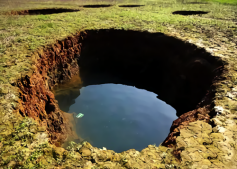
Groundwater, which billions of people rely on for drinking, irrigation and other uses, is a lifeline for people especially in parts of the world where rainfall and surface water are not enough, such as northwest India and the southwest United States. Reductions in groundwater can make it harder for people to access freshwater to drink or to supply water to crops and can result in land subsidence (下沉).
According to a new study, many parts of the world are experiencing rapid reductions in groundwater. The research analyzed millions of groundwater level measurements from 170,000 wells in more than 40 countries. It’s the first study to piece together what’s happening to groundwater levels at a global scale, according to the researchers involved, and will help scientists better understand what impact humans are having on this valuable underground resource, either through overuse or indirectly by changes in rainfall linked to climate change.
The authors found that groundwater levels declined between 2000 and 2022 in 71% of the 1,693 aquifer (蓄水层) systems included in the research, with groundwater levels declining more than 0.1 meter a year in 36%, or 617, of them. The Ascoy-Soplamo Aquifer in Spain had the fastest rate of decline in the data they gathered, 2.95 meters per year, said study coauthor Scott Jasechko, an associate professor at the Bren School of Environmental Science and Management at University of California Santa Barbara. Several aquifer systems in Iran were among those with the fastest rate of groundwater decline, he added. The team wasn’t able to gather data from much of Africa, South America and Southeast Asia because of a lack of monitoring, but Jasechko said the study included the countries where most global groundwater pumping (抽取) takes place.
The study also highlighted some success stories in Bangkok, Arizona and New Mexico, where groundwater has begun to recover after interventions to better regulate water use or redirect water to depleted aquifers. “I was impressed by the clever strategies that have been put into action to address groundwater reductions in several places, though these ‘good news’ stories are very rare,” Jasechko said.
1.Which of the following statements is TRUE about the groundwater?
A It’s essential to people.
B It’s rare in northwest India.
C It’s only used as drinking water.
D It can cause the land to sink.
解析:选A。A细节理解题。根据第一段中的“Groundwater, which billions of people rely on for drinking, irrigation and other uses, is a lifeline for people”可知,地下水是数十亿人赖以生存的资源,是人们的生命线。由此可知,地下水对人们来说非常重要。故选A。
2.What can be learned about the new study?
A It was the first one to study groundwater.
B It was done with multiple countries’ cooperation.
C It aimed to recover the groundwater levels.
D It helped people stop overusing groundwater.
解析:选B。B 细节理解题。根据第二段中的“The research analyzed millions of groundwater level measurements from 170,000 wells in more than 40 countries.”可知,这项研究是在多国配合下完成的。故选B。
3.What’s the main idea of the third paragraph?
A The importance of the study.
B The results of the study.
C The advantages of the study.
D The limitations of the study.
解析:选B。B 段落大意题。结合第三段中的“The authors found that...”以及数据可知,本段主要介绍了这项研究得出的相关结果。故选B。
4.What does the underlined word “depleted” mean?
A Rain-soaked.
B Forced-out.
C Wide-ranged.
D Dried-up.
解析:选D。D 词义猜测题。根据后文的“I was impressed by the clever strategies that have been put into action to address groundwater reductions in several places”可知,有的地区在采取干预措施更好地调节用水或将水重新导向枯竭的蓄水层后,地下水已开始恢复,由此可推断depleted表示“枯竭的,干涸的”。故选D。